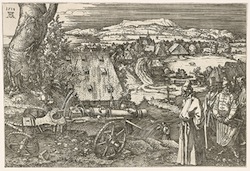Albrecht Dürer's Landscape with Cannon
Produced at a moment when the Ottoman Empire posed a threat to the West, German artist Albrecht Dürer's (1471–1528) most ambitious etching depicts a Turk standing prominently in the foreground of an expansive landscape and surveying a large cannon on a four-wheeled gun carriage. This historically significant print, the last of the artist's six etchings, not only supplements the collection of Dürer prints at the Getty Research Institute (as well as local collections) but also fills a significant gap in the Institute's extensive collections of materials regarding the Islamic world during the early modern period.
Against the background of a seaside village, a group of men dressed in Turkish costumes stands beside a large cannon. They are escorted by an infantryman armed with a halberd who leans informally on the artillery's muzzle. To his left, a companion with a horsewhip seems to direct the action outside the image; a second foot soldier stands watch to the right of the cannon just beyond the foreground ridge. Drawn with remarkably rich detail, the artillery was already considered old-fashioned by the time Dürer produced this print, and there is no doubt that he was aware of its "decommissioned" status. The meaning of this image remains enigmatic. Why is a group of Ottoman Turks standing before an outdated cannon that bears the arms of Dürer's Nuremberg? Are they prisoners? Ambassadors? The expanding Ottoman Empire was very much on the minds of Europeans in 1518, the date of this print, as the Holy Roman Emperor Maximilian I and Pope Leo X had called for a new Crusade, which failed to materialize. The modern interest in this print is manifold. First, copperplate etching had not yet been introduced to Renaissance Germany and, thus, as with the earliest etchers from around 1500, Dürer used iron plates, which rusted quickly. Prints such as this—made during Dürer's lifetime, before rust marks ruined the pictorial effect—are extremely rare. Second, the meticulously constructed landscape, with its complex perspective, is not only considered the sine qua non of the genre, it is the first etched example. Lastly, the representation of non-Western figures at the moment the West was being threatened by the expanding Ottoman Empire is highly significant. While most scholars consider the context of this print within the Holy Roman Emperor's call for a Crusade in 1518, the full range of encounters between the West and the Islamic world, including trade as well as intellectual and artistic exchange, must also be considered. | ||||||

